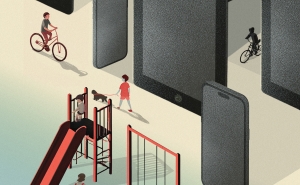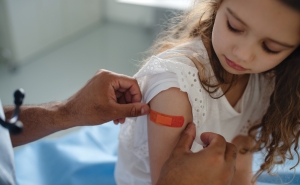Teen Mental Health During COVID-19

Disrupting school and interactions with peers, the pandemic has left teens with stress, anxiety, and other mental health challenges.
INTERVIEW BY JACKIE POWDER
For adolescents and teens, whose interactions with peers are so central to their lives and development, the pandemic’s shrinking of their world has been especially difficult.
At the Bloomberg School, researchers are learning from teens themselves how they have been weathering the pandemic, through a pilot and evaluation of the intervention program teen Mental Health First Aid (tMHFA). Supported by Lady Gaga’s Born this Way Foundation and introduced in Australia in 2015, tMHFA is a school-based training program to teach high school students how to identify and respond to signs of mental illness in their peers.
Holly Wilcox, PhD, MA, a professor in Mental Health, and Department colleagues associate scientist Elise Pas, PhD, MA, and assistant professor Sarah Murray, PhD ’15, MSPH ’11, helped to launch a pilot of tMHFA in spring 2019 in 100 schools across the U.S. Although the pandemic disrupted planned tMHFA research and expansion, Wilcox’s team included questions about its effects on teens’ mental health in a survey administered to 2,617 teens in grades 10–12 who completed the tMHFA program.
In this Q&A, Wilcox talks about tMHFA findings, expansion of the program, and the missing “safety net” of school.
How has the pandemic impacted the role of the school as “safety net?”
In most schools there are adults—even if they don’t have a mental health background—who are very good at recognizing distress or recognizing an abrupt change in students, so if they see them come in looking disheveled, looking dirty, looking sad, they can intervene. That provides a safety net to recognize child abuse, mental health-related issues, homelessness, and other concerns. During the pandemic, we haven’t had that system in place.
Before and during the pandemic you have been studying teen mental health through the teen Mental Health First Aid program. What is its goal?
The main goal is to provide students with a skill set to be able to know what to do when they are confronted with mental health crises and how and when to involve a trusted adult. It’s about teaching students how to make decisions under stressful circumstances as well as providing students with information about different mental health conditions—suicide, anxiety, and depression—and demystifying mental health services and treatment.
An important result from the Australian intervention was that students felt much more prepared to assist a suicidal peer. Similarly, our data in the U.S. showed that after tMHFA was delivered, three quarters of students reported that they would ask a peer directly if they were thinking about suicide (pre-tMHFA: 44%; post-tMHFA: 75%), and [were] much more likely to know they should involve an adult when a friend is suicidal rather than keeping it a secret (pre-tMHFA: 37%; post-tMHFA 71%).
Despite the pandemic, you were able to collect data from a six-month follow-up survey, completed by nearly 300 students. What were you looking for and what have you learned?
We asked if there had been any changes in their life due to the pandemic that created stress and problems for them and whether they relied on tMHFA skills to deal with those issues.
Well over 50% reported that the pandemic and response has created problems. A little more than 25% of students said they had experienced a “great deal” and 30% a “moderate amount” of changes, as well as stress and problems. A subset reported a “great deal” or “moderate” increase in depression [19% and 17%, respectively]. We saw very large numbers report having changes in sleep and eating patterns.
While out of school due to COVID-19, 70% of students said that they used tMHFA skills to deal with stress, and all said that the tMHFA skills they learned were helpful.
How has the pandemic impacted the U.S. rollout of the tMHFA pilot and the planned expansion?
We had over 100 schools that we were planning to work with, and fewer than half were able to implement the program before the school closures [in March 2020].
We were not able to implement tMHFA online because of safety concerns. With these types of programs, students can be triggered by the content. The instructors know what to do when they see this happen in a classroom setting, but online it’s more challenging, and the appropriate development of online content [by the National Council for Mental Wellbeing] took a lot longer than was feasible to implement last spring.
How are you and your colleagues involved in the program?
Initially, for the in-person version of tMHFA, we helped the National Council set up a platform for the collection of data and parental consent, but our role has been much more than that. We were involved in a process of cultural adaptation to make the program more representative of what American students face in different problem areas. It includes more on trauma and community-related violence. Some of the language had to be changed and the videos had to be reshot to represent more student diversity.
What do you think the longer-term impact of the pandemic might be on teens?
I’ll start with the positive. Being able to get through the pandemic builds resilience and strength to navigate uncertain and stressful circumstances in the future. It is also clear that many young people have endured isolation, exposure to adversity, and traumatic events over the COVID-19 pandemic. School systems and other youth-serving sectors should be prepared to address these challenges.
Jackie Powder is an assistant editor in the Communication & Marketing Office at the Johns Hopkins Bloomberg School of Public Health.





